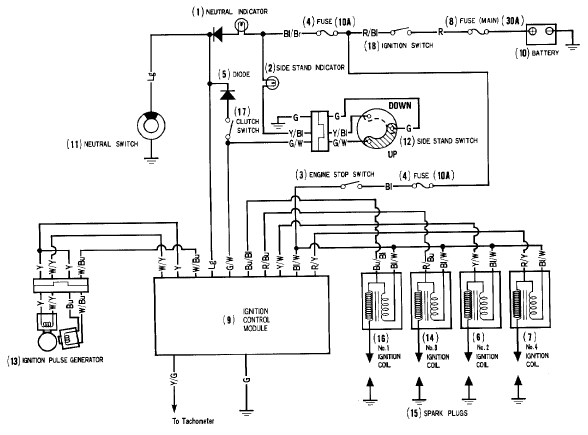-
Posts
1,317 -
Joined
-
Last visited
-
Days Won
12
Content Type
Forums
Profiles
Gallery
Blogs
Downloads
Events
Everything posted by kaldek
-

Is ignorance bliss? -- Need help with '00 charging system
kaldek replied to realistdreamer's topic in Electrical
OK so it's not just your voltage meter complaining then; either your battery is dead or your charging system is indeed shot. Dead batteries CAN pull so much current out of the charging system that the voltage drops, so it's always best to start by trying a fresh battery.- 22 replies
-

Is ignorance bliss? -- Need help with '00 charging system
kaldek replied to realistdreamer's topic in Electrical
Definitely follow the fault finding chart, it will tell you where the issues are. Low voltage when the engine is spinning slowly generally means the stator is on the way out, especially if it gets worse as the engine heats up.- 22 replies
-
No, just use it as you would a normal lead acid battery. You seriously don't need the 18 amp hour unit - why do you think you do? Remember it's 18 amp/hour "equivalent" which means it's actually about 6amp/hours in the battery. This is not a problem because it's almost impossible to get the full 18 amp/hours out of a lead acid battery before the voltage crashes, whereas the Lithium batteries will deliver nearly all of their full 6amp/hours before the output voltage drops. Also the Lithium battery will not self-drain anywhere near as fast as the lead acid, so you can leave it for weeks without the battery going flat.
-
Hmmm this seems odd. Blown head gaskets mean leaking coolant inside the cylinder, not on top of the valves. Looks to me more like it got splashed there somehow.
-
How do you know that? I called Ivan once to ask him how the FCE worked and he gave me the usual "secret sauce" garbage.
- 10 replies
-
- fuel cut eliminator
- fce
-
(and 1 more)
Tagged with:
-
Wow, totally the opposite to how I ride, which is slow in fast out. I've always felt more comfortable doing that. Doesn't mean I'm right or fast though!
-

battry=13 fuses=good new statr r/r bike dead No pwr No nothn
kaldek replied to MaxSwell's topic in Electrical
Sounds like a basic connection problem from the battery terminals! I've had that happen before so it's worth checking. Remove all wires screwed to the battery terminal posts, clean the terminals and attach all wires again. As all VFR owners know though, the source of most issues is the 30 amp fuse "all by itself" that you found. The wires and terminals in there can actually melt and disconnect. Have a very close look at it. -
OK, now I'm *really* confused.
-
You'd need to test and compare current flow of both coil types somehow. Isn't this the one case where you can just measure the resistance across the terminals of the coil, and the result is indeed the impedance? I know all our talk about resistors in series wasn't right now, but isn't this measurement an exception? No, there is more to it. Something about electromagnetic something or other. I wish Bernie would get back online to help out with this. That might mean that the CBR stick coils - even though the measured resistance is wrong - could be just fine for our purposes...
-
You'd need to test and compare current flow of both coil types somehow. Isn't this the one case where you can just measure the resistance across the terminals of the coil, and the result is indeed the impedance? I know all our talk about resistors in series wasn't right now, but isn't this measurement an exception?
-
OK so you're saying that using resistors won't stop the coil from pulling too much current. I get it!
-
Resistance in series can absolutely work. There's lots of info and circuit diagrams showing how to do this, and it's the reason why running two 1.6 ohm coils in series results in 3.2 ohms of resistance. Same thing.
-
It should, considering that the purpose of the resistor here is merely to ensure that the coil does not get overcharged and that the coil does not demand so much current that the transistors in the ECU burn out. What I'm unsure of is whether the flyback voltage (10 microsend 400 volt pulse) could damage the resistor. It would be extremely low current though, so likely not. I suppose the right resistor would be a combination of ohms and the right wattage. And that's where my knowledge gets very hazy. Right now there are electrical engineers sharing this URL and laughing their asses off, I'm sure.
-
I can't remember now if I'd clarified this (as it was last year), but it's possible that just banging on a resistor in series with the +12v feed to each coil to bump it up to 3.2 ohms could work fine. I found some articles where people are already doing this on cars when the coil primary winding resistance was too low. So if the coils are 1.6 ohm but need to be 3.2 ohm, a 1.6 ohm resistor in series with the coil could be the way to go? Ultimately we need RangerScoot to get around to backprobing his coils and measuring the current with a digital oscilloscope and ammeter. If it tops out around 7 amps on his new coils - all is good. I have all the tools needed right here....in Australia.
-
That diagram tells me that the '86 VFR750 is also TCI, as it's shared +12 volt power for all four coils.
-
Well it tells you that the bike is most likely TCI and that by merely looking at your wiring diagram you can confirm it. That means that the use of four Coil-On-Plug items of the same resistance as the existing coils will work fine, and a coil of any resistance should work fine if the EFI uses closed loop dwell control (which we haven't confirmed).
-
Lookee what I found - a 4th-gen ignition diagram. So it's definitely TCI, as all the coils share the same 12 volt feed from the engine stop switch. Same wire colour as on the 6th-gen too - Black/White. This wire colour is used as the common 12 volt feed for anything which needs a 12 volt source all the time the ignition switch is on and the Engine Stop switch is on.
-
I actually didn't know the difference between CDI and TCI and had been viewing everything as TCI. Checking into it though, since all the coils I've seen are 1.6 or 3.2 ohms I don't think they're CDI - those apparently have very low resistance (0.3 ohms or so). It's impossible to measure the resistance of the 6th-gen coils because they have the transistors inside the coil itself. I would guess that the 6th-gen is also TCI, as the coils are permanently fed 12 volts on one wire, have a dedicated ground wire and the third wire is the switch. This single wire should reasonably only be able to control a transistor that switched the 12 volt feed into the coil on (charge the coil), then off (collapse the field). So it's most likely TCI. Another way of checking if a bike uses TCI or CDI is to look at the way the coils (2-wire coils anyway!) are powered. If they share a common +12 volt feed and have individual ground wires going back to the control box, then they're TCI. However if they share a common ground but have individual positive wires going to the control box, then they're CDI.
-
I use the seriously poisonous gasket remover spray from Permatex. Works a treat, but you do not want to breathe it in or get it on your hands.
-

I dun sumpin bad... induced a short somewhere in electrical system
kaldek replied to angst's topic in Electrical
Like I said, anyone with a decent knowledge of electrics can knock up a solution, and here it is! It's a bit confusing to picture what he's saying though. I think I can almost picture the circuit but maybe a diagram from Tightwad will help.- 11 replies
-
- electric
- turn signal
- (and 4 more)
-
Yep that's the way it's done. It only ever works if one of the new coils is half the resistance/ohms of the oil dual coil pack. So even though some of your other bikes will be dual-coil they may not be 3.2 ohms. If the original dual coil packs are much lower than 3.2 ohms, you will overcharge the new coils (too long a dwell time) and blow the coils/wear the plugs out fast, or undercharge the coils (too short a dwell time) and get poor spark. Unless your CDI has closed loop dwell control of course, in which case pretty much anything should work.
-
That's easy - run them in series as wasted spark. It's already a dual-coil (rather than quad-coil) setup isn't it? If it's wasted spark 3.4 ohms each coil with dual coils you just wire two 1.6 ohm stick coils in series. (1 & 4 and 3 & 2).
-
He's probably disconnected another vacuum hose accidentally, probably the fuel pressure regulator hose. It connects to the two right-hand side cylinders so he's probably tried to sync the bike to cylinder #4 when that was already out of whack. There's also the flapper valve vacuum hose on the front left cylinder, and if it's a US-model bike with the evap cannister it has an extra vacuum line again for ALL the cylinders which can also be accidentally disconnected.
-

Anyone attempt to connect radiators in series?
kaldek replied to tinkerinWstuff's topic in Modifications
So how about a link then? As I said in my OP, I've read plenty on the fan mod but have never seen a discussion on routing the hoses differently. Sorry I meant the "spin your fan backwards" thread. http://www.vfrdiscus...6th-generation/ http://www.vfrdiscus...e__hl__radiator Basically lots of folks saying the stock design is flawed, yada yada. But, has anyone heard of a VFR overheating and warping the heads? I've been on the forum here for ten years and I don't recall a single one. My opinion is that the stock design works best when the bike is stationary or moving slowly. If you flip the fan, it will work WORSE when the bike is stationary because it's pulling already-hot air from the engine rather than cooler air from the outside. Someone at Honda ran the numbers on this and they were obviously right, because no VFRs have yet overheated and blown head gaskets or warped heads. In this case, stock works. As for the running the radiators in series, you may find that the pump hasn't got the balls to move the coolant around and may just cavitate, creating a lot of froth and not much movement of coolant. -

Anyone attempt to connect radiators in series?
kaldek replied to tinkerinWstuff's topic in Modifications
Honestly, this argument has been done to death in various forms. People spinning their fans backwards because "it's better than the Honda design" went on, and on, and on. Have you seen the cooling fan on a CBR1000RR? It's about one-eighth the size of the radiator, in the upper right corner. That's it - and it works. Our bikes have two radiators, and the fan is basically the same size as the entire left-side unit. It's fine, it works, and I've seen it keep my bike at 231F when the ambient air temperature was 116F! This was in traffic, too.


